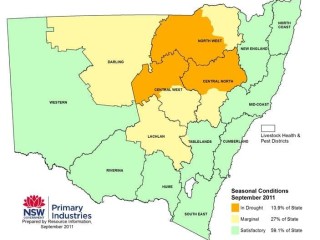 After such a wet start to the year it seems hard to believe that areas of eastern Australia are already back in the throes of drought feeding.
After such a wet start to the year it seems hard to believe that areas of eastern Australia are already back in the throes of drought feeding.
Among those that are is central northern NSW, one of the few areas that missed the flooding rains brought by an extreme La Nina event last summer.
After a dry autumn and winter, Tamworth-based beef extension officer Alastair Rayner, Industry & Investment NSW, said calls for advice on feeding cattle were now flowing in from producers throughout the North West Slopes.
Inquiries were coming mainly from a region stretching from the Upper Hunter through to Narrabri and Moree.
Most properties had finished calving, and the focus now was on getting cows to cycle efficiently in time for the summer joining, which is only a few months away.
Many cows were in lower condition and closer to the fat score 2 range, the level at which they start to utilise body tissue and were losing live weight, not just fat weight.
Mr Rayner said producers in affected areas had used up most of their dry feed so protein supplementation to leverage available grass was unlikely to be an efficient option.
On the positive side the North West Slopes was an area that had good access to a variety of grains and many people had grain stored away.
Most inquiries he has fielded have involved questions about feeding lupins, barley, oats and cotton seed.
It may not be a thought to savour, but the advice is to hope for the best and plan for the worst. Good planning now should avoid forced decisions later such as having to sell stock that are losing condition onto a falling market if rain doesn’t fall.
Mr Rayner said droughts did not happen overnight but people who left their planning and decision making to the last minute were still caught by surprise.
“We’re encouraging people to think about this period as almost the early onset of the drought and we should be having the drought plan back in place.
“So if we’re going to feed what is the most valuable animal to feed so we get the best return on that investment, but also what animals can we afford to sell, what are our options, how do we destock, and then what are the trigger points that we should be acting upon, so if it hasn’t rained by what date what do we do next.
“So really we’re trying to get people to think back to those drought lessons that we had which is basically reactivate that drought plan.
“If the season turns around that’s fine, if it doesn’t at least people are much more in control of where they are.”



HAVE YOUR SAY